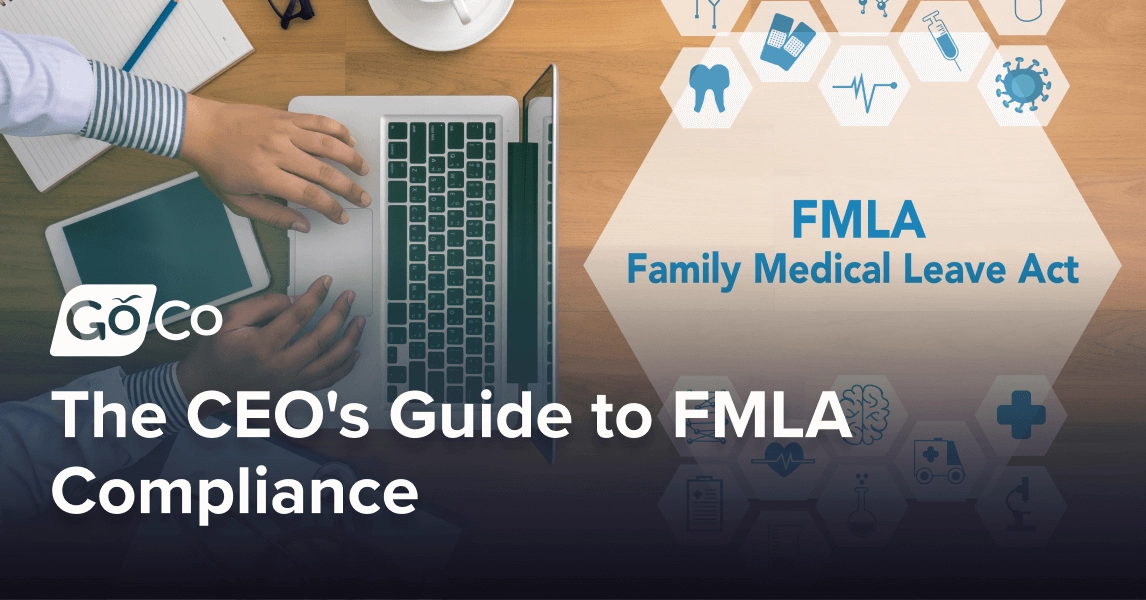The CEO's Guide to FMLA Compliance
Learn key strategies for CEOs to manage FMLA compliance, ensuring legal protection and employee well-being.
October 18th, 2024
As a CEO, navigating the complexities of the Family and Medical Leave Act (FMLA) can be a daunting task. Understanding the legal framework surrounding FMLA is crucial for ensuring compliance and effectively managing your workforce.
Staying informed about FMLA regulations not only helps you avoid potential legal pitfalls but also fosters a supportive work environment that prioritizes the well-being of your employees.
How to Understand FMLA Compliance for Executives
The FMLA is a federal law that requires covered employers to provide eligible employees with up to 12 weeks of unpaid, job-protected leave for qualifying family and medical reasons. This legal framework sets the foundation for how companies must handle employee leave requests and maintain compliance with the law.
As an executive, it's essential to grasp the key components of FMLA, including:
Employer coverage requirements
Employee eligibility criteria
Qualifying reasons for leave
Notice and certification procedures
Job protection and benefits continuation
Incorporating FMLA compliance into your company's policies and practices is vital for several reasons:
Ensuring fair and consistent treatment of employees
Mitigating the risk of legal disputes and financial penalties
Promoting a positive work-life balance for your staff
Attracting and retaining top talent who value family-friendly policies
To further enhance your understanding, consider exploring employee benefits compliance to ensure all aspects of your company’s leave policies are aligned with current legal standards.
Key Takeaway: CEOs must prioritize understanding FMLA compliance to create a legally sound and supportive work environment that benefits both the company and its employees.
CEO Responsibilities in FMLA Compliance
As the CEO, you play a crucial role in ensuring your organization's compliance with the FMLA. Your strategic leadership and commitment to adhering to these regulations set the tone for the entire company. Here are some key actions you can take to integrate FMLA into your organizational policies:
Develop a comprehensive FMLA policy that aligns with the law's requirements and your company's values. This policy should clearly outline eligibility criteria, leave entitlements, and the process for requesting and approving leave.
Train your management team and HR staff on the intricacies of the FMLA, ensuring they understand their roles and responsibilities in administering leave requests and maintaining compliance.
Foster open communication with your employees about their FMLA rights and your company's policies. Encourage them to approach their managers or HR with any questions or concerns regarding family and medical leave.
Regularly review and update your FMLA practices to stay current with any changes in the law or best practices in leave management. Utilizing HR compliance software can help streamline this process and ensure adherence to legal standards.
Key Takeaway: As the CEO, you must take a proactive approach to FMLA compliance by developing robust policies, training your team, promoting open communication, and staying up-to-date with legal requirements. By prioritizing FMLA compliance, you demonstrate your commitment to your employees' well-being and protect your company from potential legal risks.
Strategic FMLA Management Approaches
As a CEO, exploring effective managerial strategies for FMLA compliance is crucial for aligning your company's policies with business operations. One key approach is to establish clear communication channels between employees, managers, and HR. This ensures that all parties understand their roles and responsibilities in the FMLA process, minimizing confusion and potential compliance issues.
Another strategic management approach is to develop a centralized system for tracking and managing FMLA leave requests. This can include:
Implementing software solutions that streamline the leave request and approval process
Maintaining accurate records of employee leave balances and usage
Regularly reviewing leave patterns to identify potential abuse or misuse of FMLA leave
By leveraging technology and data-driven insights, CEOs can make informed decisions about FMLA management that support both employee well-being and business objectives.
Best practices for aligning FMLA policies with business operations include:
Conducting regular training sessions for managers and supervisors on FMLA requirements and company policies
Developing a comprehensive return-to-work program that supports employees transitioning back to their roles after FMLA leave
Fostering a culture of open communication and support for employees who need to take FMLA leave
Key Takeaway: Strategic FMLA management approaches, such as establishing clear communication channels, leveraging technology, and implementing best practices, enable CEOs to effectively align FMLA compliance with business operations while supporting employee well-being.
Implementing FMLA Best Practices for Leaders
As a CEO, implementing best practices for FMLA compliance is essential for creating a supportive work environment that benefits both employees and employers. One crucial step is to develop a comprehensive FMLA policy that aligns with the law's requirements and your company's values. This policy should clearly outline eligibility criteria, leave entitlements, and the process for requesting and approving leave.
To ensure the effective implementation of your FMLA policy, it's crucial to prioritize training and education for your leadership team. This includes:
Conducting regular training sessions on FMLA guidelines and company policies
Providing resources and tools to help managers navigate complex leave situations, such as employee time tracking
Encouraging open communication and collaboration between HR and management
By equipping your leaders with the knowledge and skills they need to handle FMLA requests confidently, you can minimize the risk of compliance issues and foster a culture of support for employees facing family or medical challenges.
Key Takeaway: Implementing FMLA best practices, such as developing a comprehensive policy and prioritizing leadership training, enables CEOs to create a supportive work environment that benefits both employees and the company while ensuring compliance with the law.
FMLA Impact on Business Operations
The CEO's Guide to FMLA must also consider the impact of FMLA on business operations and workforce management. When employees take FMLA leave, it can temporarily disrupt workflows, productivity, and team dynamics. As a CEO, it's essential to develop strategies to mitigate these disruptions and ensure smooth operations during employee absences.
Consider the following approaches to minimize the impact of FMLA leaves on your business:
Cross-train employees to cover essential job functions during absences
Establish clear communication protocols for employees to notify managers of upcoming FMLA leaves
Develop a plan for redistributing workloads or hiring temporary staff to fill in for employees on leave
Foster a culture of teamwork and collaboration to support employees who are covering for their colleagues on FMLA leave
By proactively addressing the operational challenges posed by FMLA leaves, CEOs can maintain business continuity while supporting their employees' family and medical needs.
Key Takeaway: The CEO's Guide to FMLA should include strategies for mitigating the impact of employee absences on business operations, such as cross-training, clear communication, and contingency planning, to ensure smooth workflows and productivity during FMLA leaves.
FMLA Policy Implementation
Implementing FMLA policies in your organization is a critical step in ensuring compliance and supporting your employees. As a CEO, it's essential to provide clear guidance and resources to help your HR team and managers navigate the complexities of the FMLA. For the latest employment law updates, it's important to stay informed about any changes that might affect your policies.
To effectively implement FMLA policies, consider the following steps:
Develop a written FMLA policy that aligns with the law's requirements and your company's values. This policy should include:
Eligibility criteria for FMLA leave
Types of leave available (e.g., continuous, intermittent, or reduced schedule)
Employee rights and responsibilities
Procedures for requesting and approving leave
Recordkeeping and reporting requirements
Communicate your FMLA policy to all employees through various channels, such as employee handbooks and training sessions. Ensure that your employees understand their rights and responsibilities under the FMLA.
Train your HR team and managers on the FMLA policy and their roles in administering leave requests. Provide them with the tools and resources they need to handle FMLA situations confidently and consistently.
Establish a centralized system for tracking and managing FMLA leave requests. This can include using HR software to streamline the process and maintain accurate records of employee leave balances and usage.
Regularly review and update your FMLA policy to ensure it remains compliant with any changes in the law or best practices in leave management.
Key Takeaway: Implementing a comprehensive FMLA policy, communicating it clearly to employees, and providing training and resources to HR and managers are essential steps for CEOs to ensure compliance and support their employees' family and medical needs.
6. Navigating FMLA Compliance Challenges
As a CEO, you may face several common challenges when managing FMLA compliance within your organization. One of the most significant hurdles is ensuring consistent application of FMLA policies across all departments and levels of management. Inconsistencies can lead to perceived favoritism or discrimination, which can result in legal issues and employee dissatisfaction.
Another challenge is managing intermittent or reduced schedule leave, which can be difficult to track and may disrupt workflow. CEOs should work with their HR teams to develop clear guidelines and processes for managing these types of leave to minimize operational impact while still supporting employees' needs. Utilizing an all-in-one HR platform can help streamline these processes and ensure consistency.
To avoid legal pitfalls, it's crucial to stay up-to-date with any changes in FMLA regulations and to regularly review your company's policies and practices to ensure ongoing compliance. This may involve:
Conducting regular audits of FMLA processes and records
Providing ongoing training for managers and HR staff
Consulting with legal counsel to address complex FMLA issues
Maintaining clear and consistent communication with employees regarding their FMLA rights and responsibilities
Key Takeaway: Navigating FMLA compliance challenges requires CEOs to prioritize consistent policy application, manage intermittent leave effectively, and stay current with legal requirements to minimize risk and support employee well-being.
FMLA Decision-Making for CEOs
As a CEO, making informed decisions regarding FMLA requests is crucial for maintaining compliance and supporting your employees. When faced with an FMLA request, consider the following factors:
Eligibility: Determine if the employee meets the eligibility criteria for FMLA leave, such as length of employment and hours worked.
Qualifying reason: Assess whether the reason for the leave request falls under the qualifying categories outlined in the FMLA, such as a serious health condition or the birth of a child.
Certification: Request and review any necessary medical certifications to verify the need for leave.
Leave duration: Evaluate the anticipated duration of the leave and its potential impact on business operations.
Balancing employee needs with organizational goals is a delicate task. While it's essential to support your employees during challenging times, you must also consider the operational impact of their absence. To strike this balance:
Collaborate with your HR team to develop contingency plans for covering essential job functions during employee leaves.
Foster a culture of open communication and flexibility, encouraging employees to work with their managers to find mutually beneficial solutions.
Regularly review and adjust your FMLA policies to ensure they align with both legal requirements and your company's values.
Key Takeaway: CEOs must make well-informed decisions regarding FMLA requests by carefully evaluating eligibility, qualifying reasons, and operational impact while prioritizing compliance and employee well-being.
Leveraging Technology for FMLA Compliance
In today's digital age, CEOs can harness the power of HR technology to streamline FMLA processes and ensure compliance. By leveraging advanced software solutions, you can automate tracking, documentation, and reporting, reducing the risk of errors and inconsistencies.
The benefits of using digital solutions for FMLA management are numerous:
Centralized data storage for easy access and analysis
Automated leave request and approval workflows
Real-time tracking of employee leave balances and usage
Customizable reporting and analytics to identify trends and potential issues
Integration with payroll and benefits systems for seamless administration
Implementing a comprehensive FMLA software solution can help you navigate the complexities of leave management while saving time and resources. These tools enable you to maintain accurate records, generate required notices, and ensure consistent application of your FMLA policies across your organization. For related information, consider exploring our insights on paid parental leave policies.
Key Takeaway: Leveraging HR technology for FMLA compliance empowers CEOs to streamline leave management processes, reduce administrative burdens, and mitigate compliance risks through automation and centralized data management.
As you navigate the complexities of FMLA compliance in 2024, remember that having the right tools and support can make all the difference. At GoCo, we understand the challenges CEOs face in managing FMLA and are here to help streamline the process. Book a demo with us today to learn how our HR technology solutions can simplify FMLA compliance and empower your organization to thrive.

Subscribe to Beyond The Desk to get insights, important dates, and a healthy dose of HR fun straight to your inbox.
Subscribe hereRecommended Posts
HR's Guide to Employee Record Retention [+Checklist]
Blog Articles
Paid Parental Leave Policies for Small Businesses
Blog Articles
Search...
Product
GoCo
Resources
Articles
eBooks
Webinars
Customer Stories




